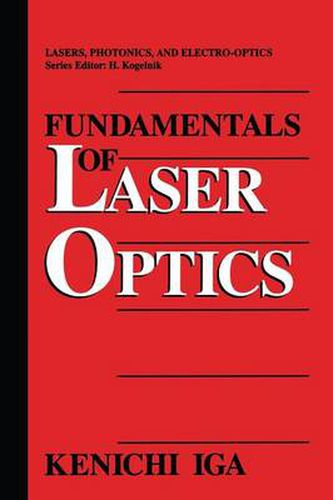Readings Newsletter
Become a Readings Member to make your shopping experience even easier.
Sign in or sign up for free!
You’re not far away from qualifying for FREE standard shipping within Australia
You’ve qualified for FREE standard shipping within Australia
The cart is loading…






This title is printed to order. This book may have been self-published. If so, we cannot guarantee the quality of the content. In the main most books will have gone through the editing process however some may not. We therefore suggest that you be aware of this before ordering this book. If in doubt check either the author or publisher’s details as we are unable to accept any returns unless they are faulty. Please contact us if you have any questions.
The laser, initially called the optical maser, was proposed in 1958 by Charles Townes and Arthur Schawlow; in 1960, Theodore Maiman was the first among several researchers to achieve laser oscillation by using a ruby crystal. In the following quarter of a century, a considerable amount of re search and development has taken place, and the laser is now utilized for many diverse applications, ranging from the commonplace compact disk to intricate surgical applications in medicine. Since I first entered the laboratory of Professor Yasuharu Suematsu in 1962 to complete my thesis, I have been studying the new field of laser optics. In spite of many expectations and a vast investment in research, the first practical use of lasers was difficult to of Univ. Erlangen once jokingly achieve. The late Professor K. H. Zchauer remarked that laser was defined by an English physicist as Less Application of Stimulated Expensive Research.
In a similiar vein, Dr. Herwig Kogelnik reminded me that in the early 1960s, maser was often called Money Acqui sition Scheme for Expensive Research.
Initially I worked with a ruby laser, then with a helium-neon-gas laser, and am presently engaged in semiconductor laser research. There are proba bly not a large number of researchers who have had the opportunity to build these three representative types of lasers. My primary objective of study lies in optical communications however, and therefore, I have been approaching the laser mainly as a lightwave propagator.
$9.00 standard shipping within Australia
FREE standard shipping within Australia for orders over $100.00
Express & International shipping calculated at checkout
This title is printed to order. This book may have been self-published. If so, we cannot guarantee the quality of the content. In the main most books will have gone through the editing process however some may not. We therefore suggest that you be aware of this before ordering this book. If in doubt check either the author or publisher’s details as we are unable to accept any returns unless they are faulty. Please contact us if you have any questions.
The laser, initially called the optical maser, was proposed in 1958 by Charles Townes and Arthur Schawlow; in 1960, Theodore Maiman was the first among several researchers to achieve laser oscillation by using a ruby crystal. In the following quarter of a century, a considerable amount of re search and development has taken place, and the laser is now utilized for many diverse applications, ranging from the commonplace compact disk to intricate surgical applications in medicine. Since I first entered the laboratory of Professor Yasuharu Suematsu in 1962 to complete my thesis, I have been studying the new field of laser optics. In spite of many expectations and a vast investment in research, the first practical use of lasers was difficult to of Univ. Erlangen once jokingly achieve. The late Professor K. H. Zchauer remarked that laser was defined by an English physicist as Less Application of Stimulated Expensive Research.
In a similiar vein, Dr. Herwig Kogelnik reminded me that in the early 1960s, maser was often called Money Acqui sition Scheme for Expensive Research.
Initially I worked with a ruby laser, then with a helium-neon-gas laser, and am presently engaged in semiconductor laser research. There are proba bly not a large number of researchers who have had the opportunity to build these three representative types of lasers. My primary objective of study lies in optical communications however, and therefore, I have been approaching the laser mainly as a lightwave propagator.